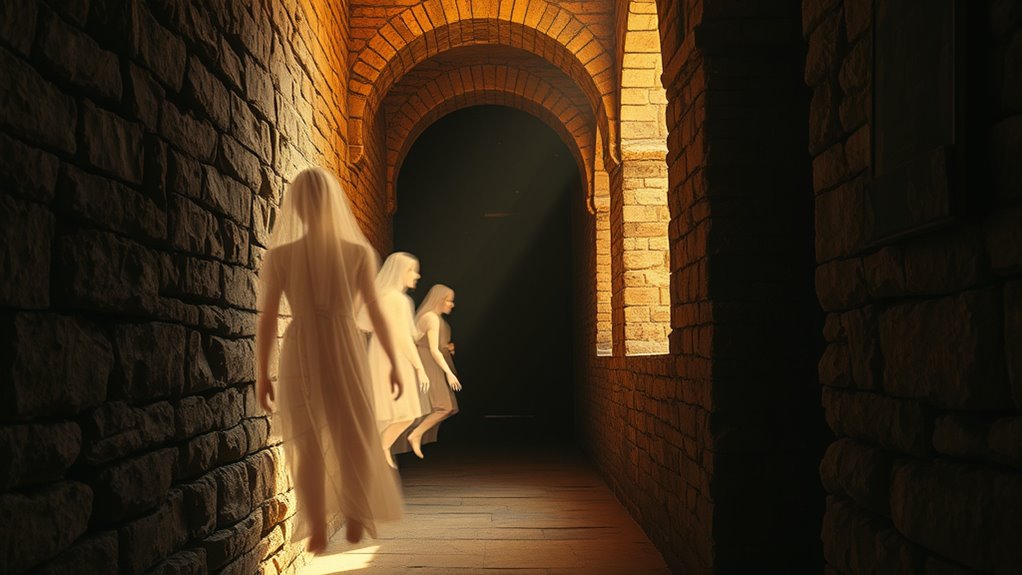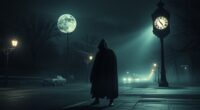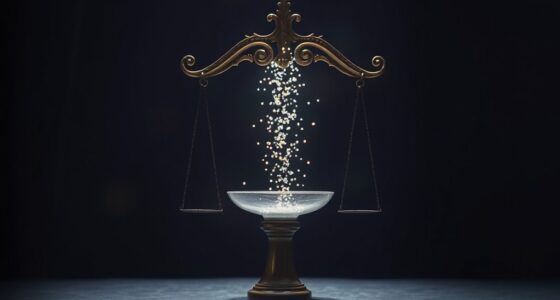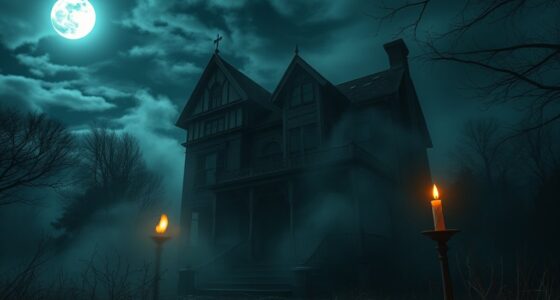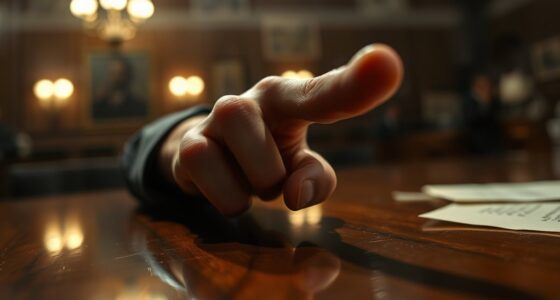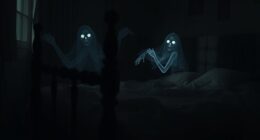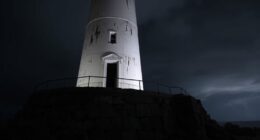The Stone Tape Theory suggests that buildings and stones can naturally record and replay residual energies from intense or traumatic events, creating ghostly phenomena. While some witnesses report unexplained apparitions and sounds, scientific skepticism remains due to limited empirical evidence and questions about how energy could be preserved in this way. Ongoing research explores environmental factors and advanced technology to better understand these claims. If you stay curious, you’ll discover more about what current studies reveal.
Key Takeaways
- The Stone Tape Theory suggests buildings can absorb and replay residual energy from traumatic events, creating ghostly apparitions.
- Scientific skepticism exists due to limited empirical evidence and lack of reproducible experiments supporting environmental recordings.
- Modern research explores environmental factors and quantum effects that might enable energy storage and playback in buildings.
- Technologies like spectrometers and AI are being used to analyze and identify consistent energy patterns linked to paranormal phenomena.
- The theory remains unproven, but ongoing scientific investigations aim to validate whether buildings can indeed record ghostly energy.
The Origins and Development of the Theory

The Stone Tape Theory originated in the 1970s when researchers began exploring the idea that certain environments can record and replay past events like a tape recorder. They proposed that haunted architecture might hold residual energy recordings from traumatic or intense moments, creating ghostly apparitions. This concept suggests that buildings and stones act as natural recording devices, absorbing energies from emotional or violent incidents. When specific conditions are met, these stored energies can be triggered, making past scenes replay as if on a tape. The theory gained popularity through media and paranormal investigations, offering a scientific-sounding explanation for sightings and unexplained phenomena in old structures. Its development marked a shift toward understanding hauntings as energy recordings embedded within the environment. Additionally, the idea aligns with emerging technologies that explore how environmental factors can influence or record information at a physical or energetic level. This perspective supports the broader field of energy recording and its potential implications for understanding environmental influences on memory. Recognizing how environmental conditions can affect energy storage helps deepen our understanding of the mechanisms behind residual hauntings. Moreover, ongoing research into environmental energy interactions continues to shed light on how physical and energetic components intertwine in these phenomena. Recent studies have also examined how specific material properties might enhance or inhibit the recording process in various structures.
Scientific Perspectives and Skepticism
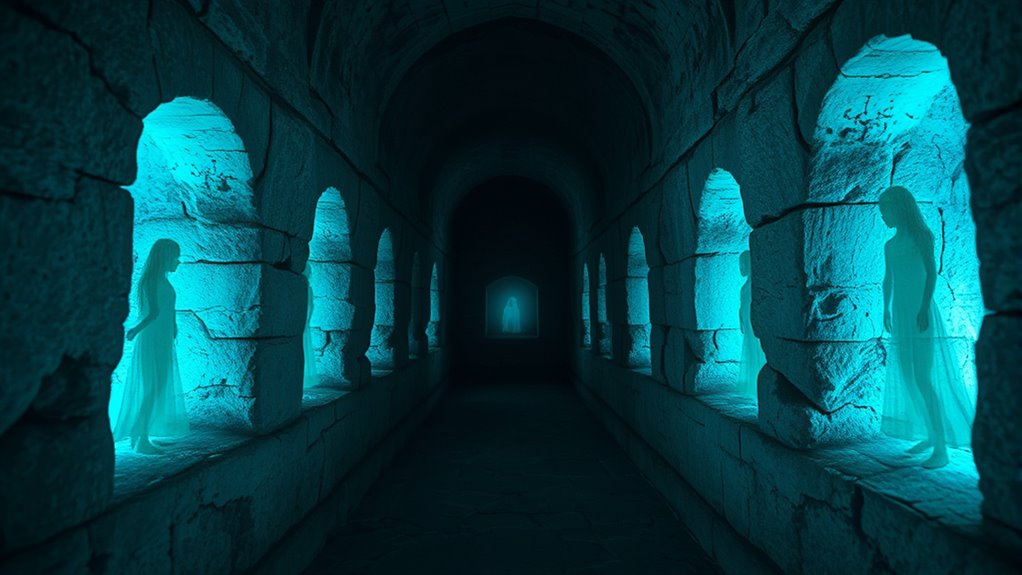
Despite the intriguing premise of the Stone Tape Theory, many scientists remain skeptical because there’s little empirical evidence to support the idea that environments can record and replay past events like a tape recorder. They question how energy preservation could occur in a way that captures and replays specific memories. Scientific skepticism arises from the lack of reproducible experiments confirming such phenomena. Some experts argue that what’s interpreted as ghostly recordings could be natural environmental effects or psychological factors. The table below highlights key perspectives:
| Perspective | Main Concern | Evidence Status |
|---|---|---|
| Scientific Skepticism | No empirical proof of energy preservation | Limited experimental support |
| Paranormal Interpretation | Possible energy recordings | Anecdotal and anecdotal evidence |
| Theoretical Models | How energy could be stored and replayed | Lacks scientific validation |
| Cultural Beliefs | Interpretations based on folklore | Not scientifically tested |
This highlights why skepticism dominates the scientific community. Additionally, current scientific understanding of energy preservation in physical environments does not support mechanisms for recording and replaying specific past events. Moreover, ongoing research into memory encoding and how the brain stores information emphasizes the complexity and currently unknown nature of such processes. Understanding how energy interactions might contribute to recording phenomena remains speculative, further complicating the debate. Furthermore, the concept of energy recording remains speculative without concrete scientific backing, leaving it open to further investigation. A scientific explanation for phenomena attributed to the Stone Tape Theory has yet to be established, which further diminishes its credibility.
Notable Cases and Anecdotal Evidence

Have you ever heard a story that seems too strange to explain by ordinary means? Many haunted locations feature eyewitness accounts that seem to support the Stone Tape Theory. For example, visitors at historic sites often report hearing unexplained footsteps or seeing apparitions that vanish when approached. Some claim to witness shadowy figures replaying scenes from the past, as if the environment records these moments. These cases are often documented by multiple witnesses, adding to their intrigue. While skeptics suggest natural causes or hallucinations, believers see these stories as evidence that buildings can hold residual energy from past events. Such anecdotal evidence fuels ongoing debate about whether locations truly store and replay ghostly impressions, making these stories compelling and widely discussed.
Implications for Paranormal Research
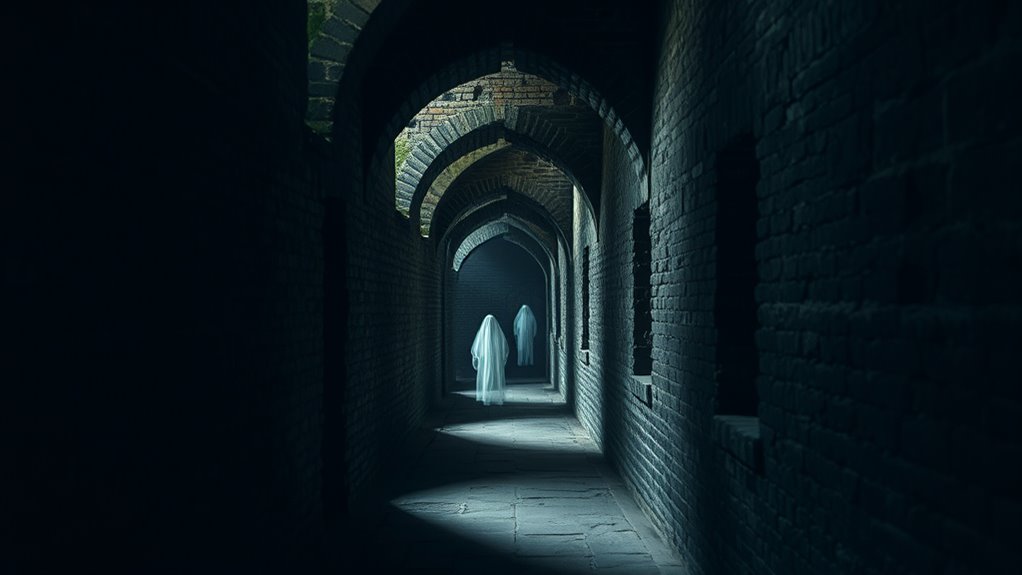
Understanding the Stone Tape Theory substantially influences how paranormal researchers approach investigations. It provides a historical context for exploring whether buildings can record and replay emotional or traumatic energy. Recognizing this helps researchers consider alternative explanations for ghost sightings, shifting focus from spirits to environmental recordings. Additionally, the theory suggests that environmental factors may play a significant role in paranormal phenomena, encouraging more comprehensive investigations. For example, certain sound frequencies and vibrations within structures could contribute to perceived hauntings, aligning with sound healing science. Moreover, advancements in environmental recording technologies enable more precise detection and analysis of these factors, enhancing investigative accuracy. Incorporating knowledge of psychological influences can also help differentiate between genuine phenomena and perceptual biases, leading to more reliable conclusions. However, this theory also raises ethical considerations, such as respecting the privacy of those connected to the sites studied. When investigating locations with sensitive histories, researchers must balance curiosity with respect for potential trauma. This perspective encourages more responsible and scientifically grounded approaches, avoiding sensationalism. Overall, the Stone Tape Theory impacts how you evaluate evidence, interpret phenomena, and navigate ethical boundaries, guiding you toward more thoughtful and methodical paranormal research.
Future Directions and Ongoing Investigations
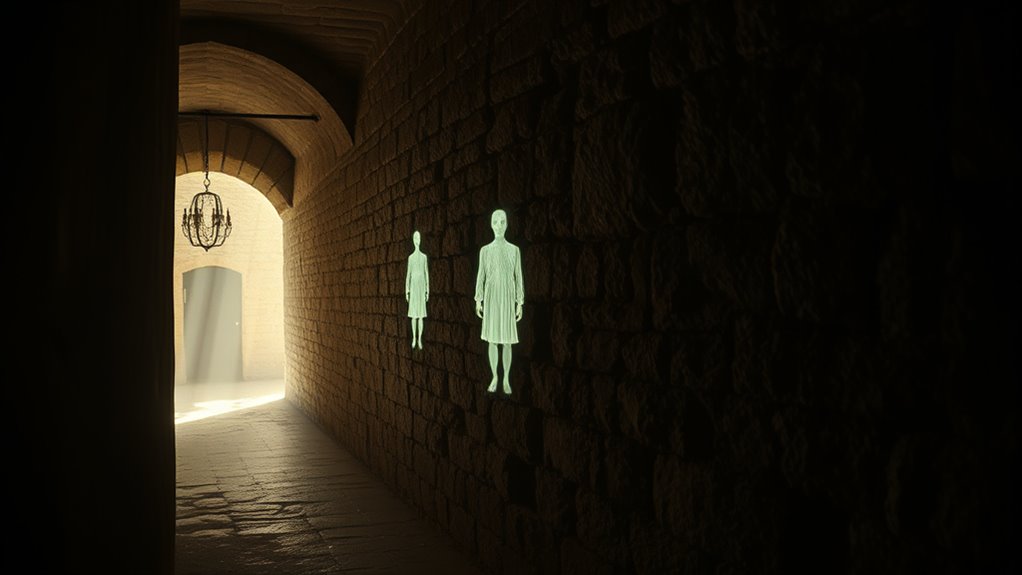
Future research on the Stone Tape Theory aims to test its validity through advanced scientific methods and technological innovations. Researchers are exploring quantum resonance as a potential mechanism behind how buildings might record and transmit energy associated with paranormal phenomena. By examining environmental factors—such as electromagnetic fields, temperature fluctuations, and geological conditions—you can better understand how these elements influence recorded energies. You might see laboratories employing sensitive equipment like spectrometers and quantum sensors to analyze building materials and their interactions with ambient energy. These efforts aim to clarify whether ghostly recordings are genuine physical phenomena or artifacts influenced by environmental and quantum effects. Additionally, ongoing studies seek to identify specific energy patterns that could substantiate the theory’s claims. Incorporating insights from AI security research may help develop more sophisticated detection tools and interpret complex data patterns associated with these phenomena.
Frequently Asked Questions
How Does the Stone Tape Theory Compare to Other Ghost Recording Hypotheses?
When considering how buildings might record ghostly energy, you explore different theories. The stone tape theory suggests energy imprinting, where traumatic events leave environmental echoes on surfaces. Unlike other hypotheses that see spirits as conscious entities, this one proposes that physical materials capture residual energy. You might compare it to ideas of electromagnetic recordings or emotional residue, but the stone tape theory uniquely emphasizes the physical recording of past energies within structures.
Are There Any Documented Scientific Experiments Supporting the Stone Tape Theory?
You might wonder if science backs the idea that buildings record ghostly energy. While there aren’t definitive experiments, some historical case studies suggest phenomena that align with the theory. Material analysis of old structures sometimes reveals residue or impressions that could support this idea. However, these findings aren’t conclusive, and more rigorous scientific experiments are needed to truly validate whether buildings can record and replay ghostly energy.
Can Modern Technology Detect or Prove Stone Tape Recordings in Buildings?
You wonder if modern technology can detect or prove stone tape recordings in buildings. Spectral imaging and electromagnetic detection offer promising ways to analyze residual energy. These tools can reveal unusual patterns or electromagnetic anomalies that might suggest stored impressions. While they haven’t conclusively proven the theory, they help you investigate potential ghostly energy recordings by identifying subtle signals or visual distortions that could align with the idea of residual hauntings.
What Are the Psychological Factors Influencing Perceived Ghostly Recordings?
You’re influenced by perceptual biases and memory suggestibility when perceiving ghostly recordings. Your mind tends to fill in gaps or interpret ambiguous stimuli as supernatural, especially if you expect to see spirits. Past experiences and cultural beliefs can shape what you perceive, making you more susceptible to ghostly impressions. These psychological factors lead you to interpret ordinary sounds or images as paranormal, even when no actual ghostly energy is present.
How Do Cultural Differences Interpret Stone Tape Phenomena Worldwide?
You’ll find that cultural interpretations shape how people perceive stone tape phenomena worldwide. Different societies have unique belief variations about ghostly recordings, influencing their explanations and acceptance of such events. For example, some cultures see them as spirits or ancestral echoes, while others dismiss them as natural or psychological phenomena. Your understanding of these beliefs helps you appreciate why interpretations vary, highlighting the profound influence of cultural context on ghostly experiences.
Conclusion
As you consider the stone tape theory, remember that buildings are silent witnesses, storing echoes of the past like ancient tapes recording history’s whispers. Whether these echoes are ghosts or mere energy, they symbolize our longing to understand what lingers beyond our grasp. Behind every stone lies a story waiting to be uncovered, a silent demonstration to memories etched in time. In exploring these echoes, you reveal a deeper connection to the unseen layers of existence.
